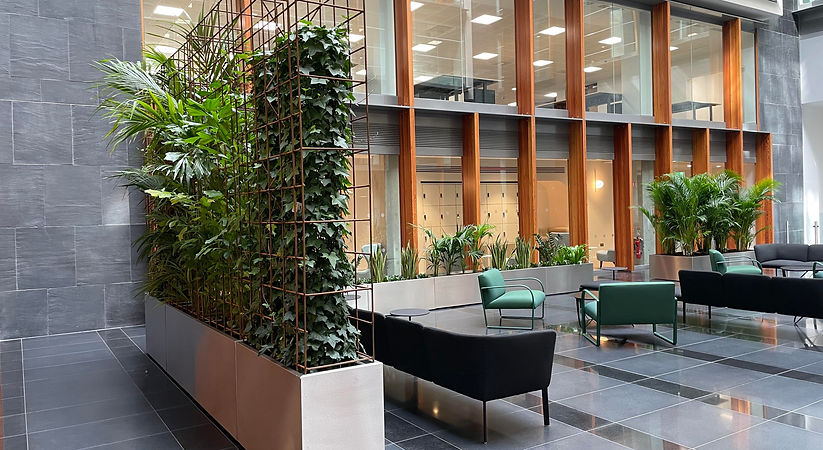Our customers are saying

"Nurtio helps us to identify problems that need to be clarified, e.g., larger trees up to 5 meters"
Michael Caffrey, Universal Floral
Growth, sustainability and technological innovations: insights from Universal Floral's Michael Caffrey on interiorscaping and biophilic design
Hi Michael! First and foremost, thank you for finding time in your busy schedule to talk to us. Would you mind telling us a bit more about Universal Floral, the company you manage?
Hi team Nurtio, very lovely to meet you. Universal Floral is based in Dublin, Ireland. We are an internal and external landscaping and biophilic design company. We have been in operation for over 50 years. Our clients range from SMEs to global blue-chip companies. Our passion is about plants and providing a customer-centric service.
We are always trying to evolve with the ever-changing landscaping industry, so we are looking to continually upskill our staff and learn about new developments that could be beneficial to improving the service we provide.
It's amazing that being based in Dublin, you manage to service customers all over Europe. Could you please tell us more about your experience with subcontracting maintenance to local partners?
We are fortunate that many leading companies have opened their first EU offices in Ireland, which has allowed us to grow with them as they have opened additional offices around Europe.
As many companies like to keep the same uniform look in their offices, we have replicated our initial offering to the other sites. We then work with local vendors on the upkeep of the plants using technology and communication to manage plant health and maintenance programmes.

As you work with a lot of international and high-tech customers, are there any specifics when servicing such customers? Do you have any tips for your colleagues who want to tap into this market segment?
Sustainability has come to the forefront of most companies' mission statements. The circular economy is something we also need to adapt to. We must show that we are part of this; where do we source our products? What are the forms of transport used to provide our service? Using hi-tech products like Nurtio shows clients that we can focus on conserving our water usage and thus only using what is required when servicing plants in clients' offices. Our clients are now much more focused on how we provide our service, and how we run our business is very important to doing business with them.
You have been one of the earliest adopters of the Nurtio products - the sensor-based Nurtio Protect and, since recently, Nurtio Insight. What drives you to try out and adopt new technologies?
The industry has advanced a lot in the last few years, and if we need anything that can help us provide a better service, we are open to exploring. Nurtio Protect helps us to identify problems that need to be clarified, and an example of this would be larger trees up to 5 meters. The larger the planter, the more difficult it is to see what is going on within. Nurtio Protect provides all the information that allows us to create a maintenance program that ensures we create optimal conditions for the benefit of the trees and plants. New technologies make it easier to manage our product, and this, in turn, ensures we can offer a better service to our clients.

By doing projects all over Europe, you can probably see a lot of different approaches to the plant service business in different regions. Are there any striking differences in how companies do plant maintenance you would like to share? What impressed you the most in your experience?
In Ireland and the UK, I have noticed that soil is mainly used as the substrate, whereas, in Europe, it tends to be Hydro culture. One of the other main things I have noticed is that using large trees in lobbies and denser plant displays is much more prevalent in the UK and Europe. What has really impressed me is the use of artificial light is much more noticeable; this makes a considerable difference in preserving the plant's lifespan and highlights a stunning display that could be the focal point for displaying biophilic design within a building.
Do you have any ideas about where our industry is going? What do you think it will look like in 5, 10, or even 20 years?
The industry has become very popular over the last few years; plants are in vogue, and that will stay the same. New products will come onto the market, making it easier to manage and look after plants. My concern is disease and growers having to force the growth of plants to fulfil the corporate and consumer markets, thus, providing a substandard product. The urban landscape will be the big thing within the next 20 years; cities will try to replicate the likes of Singapore, living buildings will become more common, and street furniture will have integrated planting systems.

Finally, do you have any tips or advice to share with your colleagues from all over the world?
I advise you to enjoy your work; we provide products and services that enhance environments and bring life to spaces. Plants make a space more aesthetically pleasing and improve the moods of the people within that space, let us continue to do this and bring smiles to people's faces.
Thank you, Michael! Working with your company always gives us a lot of inspiration, and we hope to continue our partnership in the years to come.
